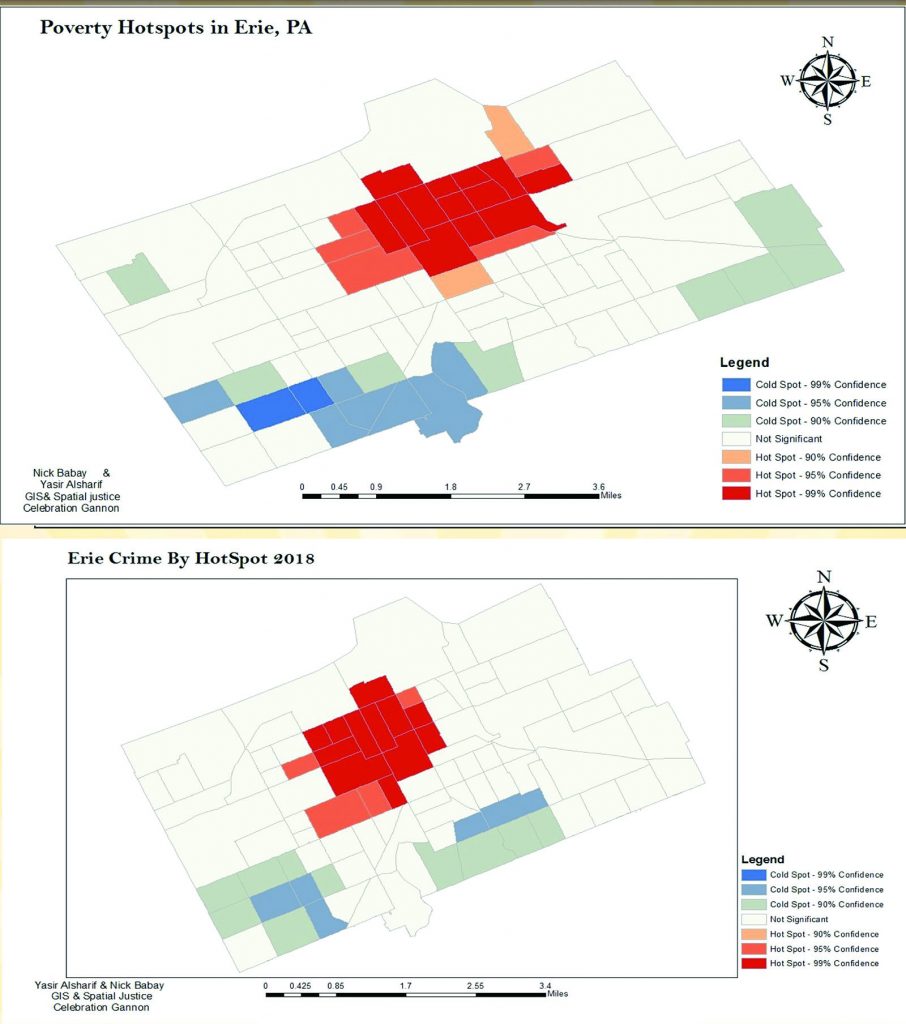Another headline reports a man fatally shot. A drug deal went wrong. A fight broke out. A burglary occurred. Erie residents are almost desensitized to the articles at this point, writing off an area where crime occurs as a “bad part of town.”
The areas where the most crime occurs in Erie County seem to overlap the run-down, impoverished neighborhoods. Young men and women find themselves in a trying situation as their surroundings seem to point toward crime. Is it necessarily caused by poverty? That’s the question that Dan Spizarny, Erie’s chief of police, says needs to be asked.
“Poverty and crime are two separate things,” Spizarny said. “Is it a direct cause of crime? I don’t think so, but is it a symptom of other societal issues that affect crime? Yes.”
Seeing crime firsthand every day, Spizarny said he rarely ever thinks to himself, “I know why they did it.” Although there is some truth, he said, in poverty affecting crime, it is never an excuse for crime.
“It’s hard to justify because if you look at what’s being stolen, they’re not stealing livable supplies,” Spizarny said. “With poverty you think, lack of food, but they’re stealing televisions, DVD players, gaming systems. When they go steal shoes, they’re stealing the Michael Jordans. They’re stealing status.”
It is less of a “survival mode” tactic when burglaries in Erie occur. Spizarny said that in his experience, it’s more of a way for people to get what they want easily. There are rarely any crimes in which impoverished families are stealing something they need to survive.
Spizarny said more than 80% of crimes committed deal with addiction, not someone stealing food for his/her empty pantry. These are criminals addicted to drugs, alcohol, gambling and not committed to helping their families.
A recent geographical information system (GIS) mapping project done at Gannon University showed the overlapping of areas that experience crime and poverty. These areas tend to be on the East Side or near the lower West Erie Bayfront.
“Although poverty may affect those areas,” Spizarny said, “the lack of education, lack of empathy and respect for others and the decline of the family unit may all be better explanations for crime.”
Katherine Harkins, a student involved in the GIS mapping program, looked at the correlation between homicide and urban poverty in Erie.
After seeing the results were very closely related, Harkins began to look deeper into the issue. A great deal of the cases came back to the youth.
“A lot of the issue is that they’re (kids) surrounded by such poor conditions that the neighborhoods are targeted for criminal activities, and I do believe that children are very impressionable,” Harkins said. “It’s really important to focus on the early development stages of childhood, and it’s fascinating to see how outside influences can have a huge effect on children.”
According to District Attorney Jack Daneri, multiple risk factors for adolescent development could affect a child’s future. These factors are split into categories of community (such as availability to drugs and/or firearms, community disorganization and extreme economic deprivation), family (family conflict or parental attitudes toward problem behavior), school (lack of commitment to school or academic failure beginning in late elementary school) and peers (friends who engage in problem behavior, early and persistent antisocial behavior, rebelliousness).
“Poverty is just one risk factor,” Daneri said. “Simply because you’re poor doesn’t mean you’re destined for crime.”
Daneri referenced a study that followed children throughout their early developmental stages and found that by third grade, a child’s future has already been determined, whether that means continuing with higher education or going to prison.
Even if there is no one telling the kids in an impoverished neighborhood that they won’t succeed, there are often subtleties detected over time, such as a difference in clothing or language that serves as a constant reminder of someone’s lower status.
Daneri said the biggest obstacle is that there is no sense of hope in those areas. They look around and see their conditions and feel as though they can’t succeed beyond what has been given to them, or the lack thereof.
Statistics show that in times like the Great Depression, when the economy was at its worst and families were struggling to make ends meet, there was a lower amount of criminal activity.
Patrick Sharkey, a sociologist at New York University, has done multiple studies in cities like Chicago and Los Angeles, where places that have pockets of serious violence and high crime rates give way to the fraying community around them. In one study, he found that children performed worse on vocabulary and reading assessments when a homicide occurred in their neighborhood within the previous week.
When children are surrounded with risk factors like favorable attitudes to problem behaviors and family conflict, it can be difficult for the child to focus or do well in school, so they turn to the life of violence they are familiar with. To stop this cycle of crime that occurs in various scenarios, Daneri said that early initiatives are the most important steps.
By using protective factors like religiosity, community opportunities and rewards for pro-social involvement, Erie County is teaching children how to do good things in their community and have a purpose greater than the negative thoughts they may already have ingrained in their minds.
Assistant U.S. Attorney Chris Trabold remarked that areas like the lower West Side and the East Side are both relatively bad as far as crime goes, but less than 10% of the community commits crime. In most of these communities, it is a group of chronic violent offenders that create a negative atmosphere.
Upon looking past the headlines, read the article and find out that the man who was fatally shot was in a drug deal gone awry. The young men charged for his death are in their 20s and have been to jail before.
Trabold said the programs Erie is implementing work to combat these chronic criminals who live their lives in and out of jail.
One of these programs is Unified Erie, a violence reduction initiative that focuses on prevention, enforcement and re-entry in the community.
Daneri, known for his significant role in the Unified Erie community, said that very early on in children’s lives is when they are shaped and influenced, so the prevention aspect is especially important.
Unified Erie has a family team that increases awareness of parenting resources in the area, a community team that works on increasing the health of various neighborhoods at a grassroots level and a religiosity team that works to increase youth participation in organized religion.
Trabold emphasized the enforcement aspect, saying that it has helped immensely with chronic violent offenders, reducing the amount of people who become reincarcerated. What was once a 70%-80% reincarceration rate in Erie County is now below 20%.
The last approach of Unified Erie deals with re-entry into the community after being released from prison. The Erie County Re-Entry Services and Support Alliance (ECRSSA) works to help those individuals newly released from prison to find health care, access to education, housing and employment.
Daneri said something as simple as teaching someone how to ride the bus can help them get a job if they have the mindset that they don’t have a job so they can’t afford a car to be able to go to work anyway.
Daneri stressed that not knowing basic skills can lead to low self-esteem, and a big factor of these programs is to build a better self-image so that, in turn, the individual will be a greater role model in the community.
Other resources in the community include a number of social service and safety nets. Another example is the St. Martin Center.
St. Martin’s has an early learning center to help children receive a quality education where they are in a safe learning environment that supports them. There is also a self-sufficiency department that assists those in need in the community by supplying basic needs like food and clothing, as well as providing housing and financial counseling for those struggling economically.
“Programs I think are important do emphasize being proactive,” Daneri said. “It’s all about increasing the odds for good.”
Spizarny said that although all the headlines seem to be about crime happening once again in Erie, compared to three years ago, the crime has decreased significantly. Crimes such as shootings that happened two to three times each week have been reduced to once every two to three weeks. He said it has a lot to do with perception and people thinking the situation is worse than it actually is.
With resources in place and those impacted by the newer programs beginning to enter the community, there’s a greater opportunity for change. Trabold said focusing on the areas in the community that need help the most, like those who are impoverished, gives them a bigger purpose in life and focuses on a more positive future.
“If you reach a couple of people, you give them a way out,” Trabold said. “We try to get those people struggling and give them lots of opportunities.”
CHLOE FORBES
[email protected]












